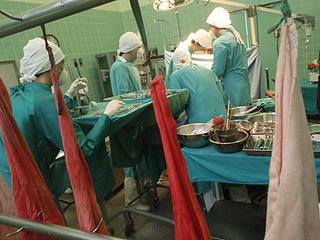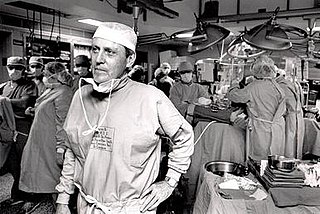
Christiaan Neethling Barnard was a South African cardiac surgeon who performed the world's first highly publicized heart transplant and the first one in which the patient regained consciousness. On 3 December 1967, Barnard transplanted the heart of accident-victim Denise Darvall into the chest of 54-year-old Louis Washkansky, with Washkansky regaining full consciousness and being able to easily talk with his wife, before dying 18 days later of pneumonia. The anti-rejection drugs that suppressed his immune system were a major contributing factor. Barnard had told Mr. and Mrs. Washkansky that the operation had an 80% chance of success, a claim which has been criticised as misleading. Barnard's second transplant patient Philip Blaiberg, whose operation was performed at the beginning of 1968, lived for a year and a half and was able to go home from the hospital.

Organ donation is the process when a person allows an organ of their own to be removed and transplanted to another person, legally, either by consent while the donor is alive or dead with the assent of the next of kin.
A brain transplant or whole-body transplant is a procedure in which the brain of one organism is transplanted into the body of another organism. It is a procedure distinct from head transplantation, which involves transferring the entire head to a new body, as opposed to the brain only. Theoretically, a person with advanced organ failure could be given a new and functional body while keeping their own personality, memories, and consciousness through such a procedure.

Organ transplantation is a medical procedure in which an organ is removed from one body and placed in the body of a recipient, to replace a damaged or missing organ. The donor and recipient may be at the same location, or organs may be transported from a donor site to another location. Organs and/or tissues that are transplanted within the same person's body are called autografts. Transplants that are recently performed between two subjects of the same species are called allografts. Allografts can either be from a living or cadaveric source.
A head transplant is an experimental surgical operation involving the grafting of one organism's head onto the body of another; in many experiments the recipient's head was not removed but in others it has been. Experimentation in animals began in the early 1900s. As of 2019, no lasting successes have been achieved.

A pancreas transplant is an organ transplant that involves implanting a healthy pancreas into a person who usually has diabetes. Because the pancreas is a vital organ, performing functions necessary in the digestion process, the recipient's native pancreas is left in place, and the donated pancreas is attached in a different location. In the event of rejection of the new pancreas, which would quickly cause life-threatening diabetes, there would be a significant chance the recipient would not survive very well for long without the native pancreas, however dysfunctional, still in place. The healthy pancreas comes from a donor who has just died or it may be a partial pancreas from a living donor. At present, pancreas transplants are usually performed in persons with insulin-dependent diabetes, who can develop severe complications. Patients with the most common, and deadliest, form of pancreatic cancer are usually not eligible for valuable pancreatic transplantations, since the condition usually has a very high mortality rate and the disease, which is usually highly malignant and detected too late to treat, could and probably would soon return. Better surgical method can be chosen to minimize the surgical complications with enteric or bladder drainage. Advancement in immunosuppression has improved quality of life after transplantation.

Liver transplantation or hepatic transplantation is the replacement of a diseased liver with the healthy liver from another person (allograft). Liver transplantation is a treatment option for end-stage liver disease and acute liver failure, although availability of donor organs is a major limitation. The most common technique is orthotopic transplantation, in which the native liver is removed and replaced by the donor organ in the same anatomic position as the original liver. The surgical procedure is complex, requiring careful harvest of the donor organ and meticulous implantation into the recipient. Liver transplantation is highly regulated, and only performed at designated transplant medical centers by highly trained transplant physicians and supporting medical team. The duration of the surgery ranges from 4 to 18 hours depending on outcome. Favorable outcomes require careful screening for eligible recipient, as well as a well-calibrated live or cadaveric donor match.

Transplant rejection occurs when transplanted tissue is rejected by the recipient's immune system, which destroys the transplanted tissue. Transplant rejection can be lessened by determining the molecular similitude between donor and recipient and by use of immunosuppressant drugs after transplant.
Post-transplant lymphoproliferative disorder (PTLD) is the name given to a B-cell proliferation due to therapeutic immunosuppression after organ transplantation. These patients may develop infectious mononucleosis-like lesions or polyclonal polymorphic B-cell hyperplasia. Some of these B-cells may undergo mutations which will render them malignant, giving rise to a lymphoma.
Anti-thymocyte globulin (ATG) is an infusion of horse or rabbit-derived antibodies against human T cells, which is used in the prevention and treatment of acute rejection in organ transplantation and therapy of aplastic anemia.

Hematopoietic stem cell transplantation (HSCT) is the transplantation of multipotent hematopoietic stem cells, usually derived from bone marrow, peripheral blood, or umbilical cord blood. It may be autologous, allogeneic or syngeneic.
Graft-versus-host disease (GvHD) is a medical complication following the receipt of transplanted tissue from a genetically different person. GvHD is commonly associated with stem cell transplants such as those that occur with bone marrow transplants. GvHD also applies to other forms of transplanted tissues such as solid organ transplants.

Tumors of the hematopoietic and lymphoid tissues or tumours of the haematopoietic and lymphoid malignancies are tumors that affect the blood, bone marrow, lymph, and lymphatic system. Because these tissues are all intimately connected through both the circulatory system and the immune system, a disease affecting one will often affect the others as well, making myeloproliferation and lymphoproliferation closely related and often overlapping problems.
Allotransplant is the transplantation of cells, tissues, or organs to a recipient from a genetically non-identical donor of the same species. The transplant is called an allograft, allogeneic transplant, or homograft. Most human tissue and organ transplants are allografts.
A face transplant is a medical procedure to replace all or part of a person's face using tissue from a donor. The world's first partial face transplant on a living human was carried out in France in 2005. The world's first full face transplant was completed in Spain in 2010. Turkey, France, the United States and Spain are considered the leading countries in the research into the procedure.

Kidney transplantation or renal transplantation is the organ transplant of a kidney into a patient with end-stage renal disease. Kidney transplantation is typically classified as deceased-donor or living-donor transplantation depending on the source of the donor organ.

Thomas Earl Starzl was an American physician, researcher, and expert on organ transplants. He performed the first human liver transplants, and has often been referred to as "the father of modern transplantation."

Hair transplantation is a surgical technique that removes hair follicles from one part of the body, called the 'donor site', to a bald or balding part of the body known as the 'recipient site'. The technique is primarily used to treat male pattern baldness. In this minimally invasive procedure, grafts containing hair follicles that are genetically resistant to balding are transplanted to the bald scalp. Hair transplantation can also be used to restore eyelashes, eyebrows, beard hair, chest hair, pubic hair and to fill in scars caused by accidents or surgery such as face-lifts and previous hair transplants. Hair transplantation differs from skin grafting in that grafts contain almost all of the epidermis and dermis surrounding the hair follicle, and many tiny grafts are transplanted rather than a single strip of skin.

Lung transplantation, or pulmonary transplantation, is a surgical procedure in which a patient's diseased lungs are partially or totally replaced by lungs which come from a donor. Donor lungs can be retrieved from a living donor or a deceased donor. A living donor can only donate one lung lobe. With some lung diseases, a recipient may only need to receive a single lung. With other lung diseases such as cystic fibrosis, it is imperative that a recipient receive two lungs. While lung transplants carry certain associated risks, they can also extend life expectancy and enhance the quality of life for end-stage pulmonary patients.

A heart transplant, or a cardiac transplant, is a surgical transplant procedure performed on patients with end-stage heart failure or severe coronary artery disease when other medical or surgical treatments have failed. As of 2018, the most common procedure is to take a functioning heart, with or without transplanting one or both lungs at the same time, from a recently deceased organ donor and implanting it into the patient. The patient's own heart is either removed and replaced with the donor heart or, much less commonly, the recipient's diseased heart is left in place to support the donor heart.












